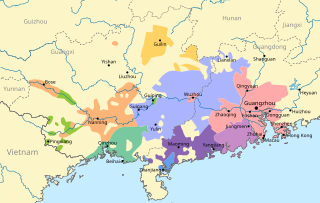Gao–Yang Yue
Branch of Yue varieties
| Gao–Yang Yue | |
|---|---|
| 高陽方言/高語 | |
| Native to | Southern China |
Native speakers | (5.4 million cited 1998)[1] |
Language family | Sino-Tibetan
|
| Language codes | |
| ISO 639-3 | None (mis) |
| ISO 639-6 | goya |
| Glottolog | gaol1235 |
| Linguasphere | 79-AAA-mc |
 Gao-Yang (lower centre), among other Yue and Pinghua groups in Guangxi and Guangdong | |
Gao–Yang, or Gao–Lei or Gao–Yu, is one of four principal Yue Chinese languages. It is spoken in around Maoming and Yangjiang in southwestern Guangdong.
The name derives from its two dialects, Gaozhou and Yangjiang.
References
- ^ Olson, James S. (1998). An Ethnohistorical Dictionary of China. Westport, Connecticut: Greenwood Press.
- v
- t
- e
Sino-Tibetan branches
(Himachal, Uttarakhand, Nepal, Sikkim)
| Greater Magaric |
|---|

(Tibet, Bhutan, Arunachal)
| "Naga" | |
|---|---|
| Sal |
| Burmo-Qiangic |
|---|
(Arunachal)
| Greater Siangic |
|
|---|
Italics indicates single languages that are also considered to be separate branches.
 | This Sino-Tibetan languages-related article is a stub. You can help Wikipedia by expanding it. |
- v
- t
- e











